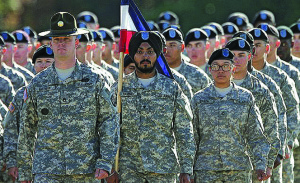January 31-2014

The Pentagon loosened up a bit last week to be more accommodating to volunteers from minority groups by making it easier to wear beards, turbans, headscarves, yarmulkes and other religious clothing with the uniform. But advocates for those groups said the new policy fell far short of what they have been seeking.
The new policy doesn’t allow anyone with a beard to just enter the armed forces. The policy still requires that anyone dressing to a religious code get an individual waiver from the service he or she is volunteering for. And then each commander of each unit that individual is progressively assigned to would have to review and renew the accommodation.
The new policy simply encourages the services to be more accommodating, without requiring it.
“The military departments will accommodate individual expressions of sincerely held beliefs (conscience, moral principles, or religious beliefs) of service members” unless it might affect military readiness or unit cohesion, the updated policy on religious accommodation said.
The policy would impact Sikhs, Muslims, Jews and members of other groups that wear beards or articles of clothing as part of their religion. It also could affect Wiccans and others who may obtain tattoos or piercings for religious reasons.
As a practical matter, however, it is only Sikhs—who wear beards and turbans—who have been pushing aggressively for decades for the rules to be changed. Sikhs have a warrior tradition and many American Sikhs actively want to serve in uniform. But few Orthodox Jews, who wear yarmulkes, or Muslim women who wear headscarves have great interest in military service. And while there are thousands of Muslims in the US military, few of them have any interest in wearing a beard.
Lieutenant Commander Nate Christensen, a Pentagon spokesman, said the change meant the new Defense Department’s policy, for the first time, encourages acceptance by the four services of beards, long hair and articles of clothing worn for religious reasons, so long as they do not interfere with “good order and discipline”—which can be difficult to define.
A service member who wants to wear a beard or article of clothing for religious reasons must seek permission from the Army, Navy, Air Force or Marine Corps. Until now, only the Army has made a small number of accommodations to its uniform policy to permit Sikhs to wear turbans and beards.
Advocates for the effected groups expressed concern that the updated policy does little to protect Sikhs and others from the whims of their commanders.
Amardeep Singh, a spokesman for the Sikh Coalition, noted that the religious accommodation would have to be approved each time a service member changed assignments and got a new commander.
“What is disappointing … is that the presumptive bar on the Sikh articles of faith remains. So a Sikh can’t just sort of enlist in the US military and expect that they won’t, down the line, have to make the false choice between their faith and their service to the country,” he said.
Army Corporal Simranpreet Lamba, one of only three currently serving observant Sikhs to have received permission to keep their hair and turban, said the updated policy was a small step in the right direction.
“I really appreciate that the Army has looked into the matter and tried to add something, but at the same time it doesn’t provide any kind of accommodation for all the Sikhs who want to join,” he said.
Lamba said it took him nine months to receive permission to keep his long hair, beard and turban but he has not had problems with the accommodation in his 3 1/2 years in the service.
He said he uses a thin turban like a bandana while wearing a helmet, and has been able to get an effective seal with his gas mask despite his beard. The gas mask has been the standard military objection to beards, which clearly did not interfere with U. S. Grant’s performance as a soldier. But Grant served a half-century before gas became a weapon.
Ibrahim Hooper, a spokesman for the Council on American-Islamic Relations (CAIR), said he welcomed any move to broaden religious accommodation in the US military.
“We’ve dealt with this issue on a number of occasions, whether it was with beards or with headscarves or even in support of the Sikh community on the issue of turbans and skullcaps for the Jewish military personnel,” he said.
“I’d have to see how it’s carried out in practice,” Hooper said. “If it’s subject to the whim of individual commanders that becomes problematic because that’s what we’ve seen in the past—some are allowed, some are denied.”
